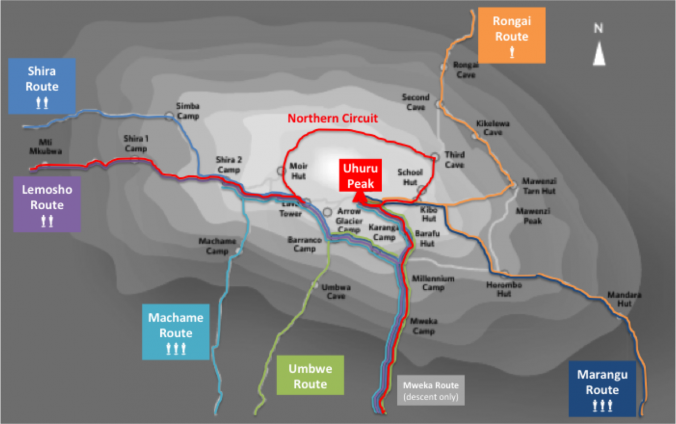Mti Mkubwa (2,800m / 9,200ft) to Shira 1 camp (3,500m/11,500ft)
Distance: 8km/5mi, 5-6 hours
Altitude: 700m/2,300ft up in elevation
Mti Mkubwa (2,800m / 9,200ft) to Shira 1 camp (3,500m/11,500ft)
Distance: 8km/5mi, 5-6 hours
Altitude: 700m/2,300ft up in elevation
Moshi (850m/2,800ft) to Lemosho Gate (2,100m/6,900ft) by car
Distance: 80km/50mi, 2-3 hours drive (5-6 including breaks); Altitude: 1,250m/4,100ft up in elevation
Lemosho Gate (2,100m/6,900ft) to Mti Mkubwa camp (2,800m / 9,200ft) by foot
Distance: 6km/4mi, 3 hours (4 if the car can’t drive all the way to the gate because of rain); Altitude: 700m/2,300ft up in elevation
The first question to get your head around when planning your own trip, and perhaps the easiest to solve, is when to go.
While theoretically hard-core hikers could go any time, practically Kilimanjaro has its seasons with vast differences in expected temperatures, sunshine, clouds, rain and snow on the summit.
Routes offered by tour operators organising Kilimanjaro climbs range anywhere between 5 and more than 9 days. So how long does it take to really climb Kilimanjaro?
Of course we all want to keep is as short as possible, right? After all, who wants to spend more time than necessary without a shower and sleeping in a tent and not showering? And the longer, the more expensive. At least that was my initial thinking…
Kilimanjaro spoils you for choice. There are six common routes as well as few less popular ones, all leading to the summit. By stated order of popularity, the traditional routes include the Machame, Marangu, Lemosho, Shira, Rongai and Umbwe routes. Choice is good, but it also adds complexity. How to even start?

Alexandra is a passionate traveler and explorer. Born in Austria and currently living in Switzerland, Tanbai is her pseudonym as a hobby writer. It is Mandarin Chinese and derived from the combination of the first character for Tanzania (坦, pronounced tăn) as well as her Chinese surname (白, pronounced bái). Incidentally, the two characters in combination (坦白, pronounced tănbái) have the meaning of being frank and honest, perhaps to the degree of confessing. And that’s what Alexandra also hopes to reflect in her writing, an authentic account of her experience including innermost feelings and emotions, positive and negative, strong and vulnerable alike. Via her writing, she hopes to foster transparency and mutual understanding, and thereby provide her tiny little contribution to making this world a better place.
Kilimanjaro Uncovered started with a simple idea – to review a little known hiking route. It ended with a truly life-changing experience – written in real time while I was unconscious of being the subject of transformation.
For more detailed information and your further reading pleasure, I would highly recommend the following books. Not all of them are directly related to Kilimanjaro, but they all had an impact on my own Kilimanjaro Uncovered journey – by providing useful information, by inspiring me, by putting things into perspective, or simply by providing good entertainment.
For more detailed information regarding Kilimanjaro and related topics, check out the following websites and blogs.
© 2025 Kilimanjaro Uncovered
Theme by Anders Noren — Up ↑